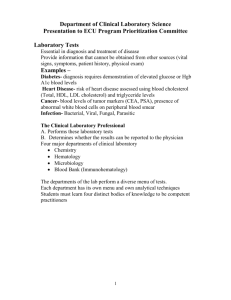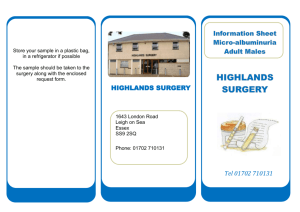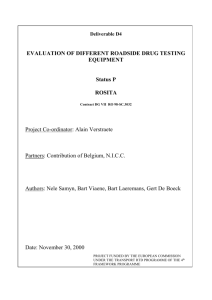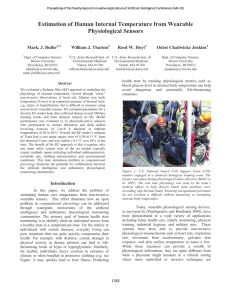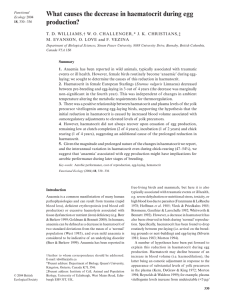Chapter 2General Methods CHAPTER 2 General Methods 2.1
advertisement
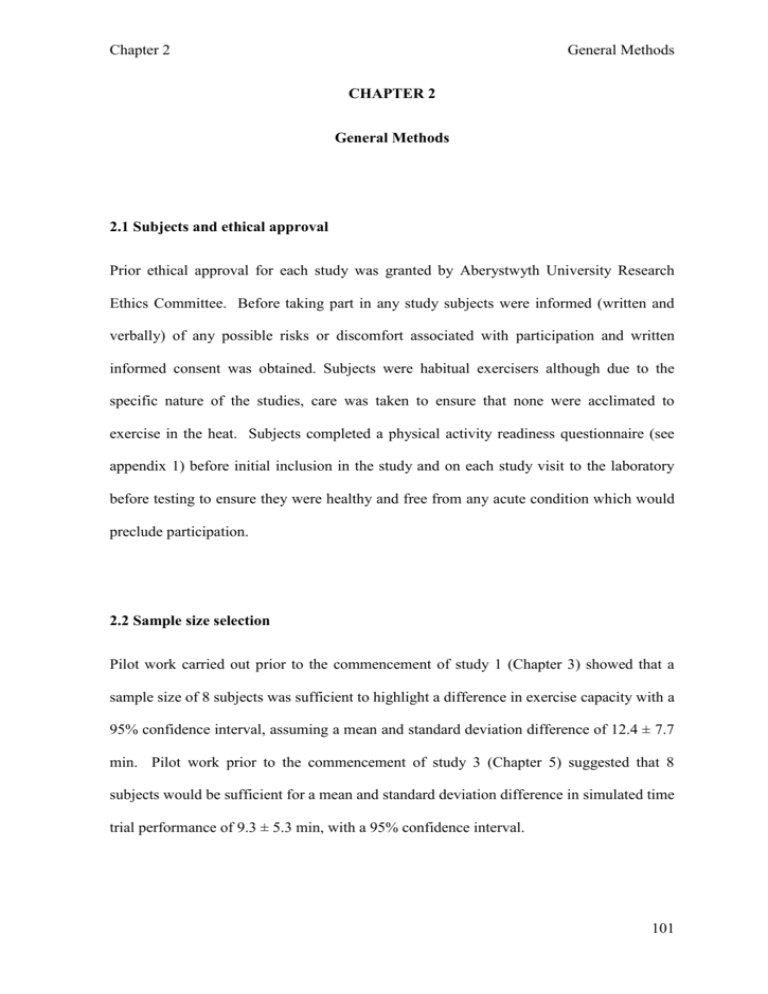
Chapter 2 General Methods CHAPTER 2 General Methods 2.1 Subjects and ethical approval Prior ethical approval for each study was granted by Aberystwyth University Research Ethics Committee. Before taking part in any study subjects were informed (written and verbally) of any possible risks or discomfort associated with participation and written informed consent was obtained. Subjects were habitual exercisers although due to the specific nature of the studies, care was taken to ensure that none were acclimated to exercise in the heat. Subjects completed a physical activity readiness questionnaire (see appendix 1) before initial inclusion in the study and on each study visit to the laboratory before testing to ensure they were healthy and free from any acute condition which would preclude participation. 2.2 Sample size selection Pilot work carried out prior to the commencement of study 1 (Chapter 3) showed that a sample size of 8 subjects was sufficient to highlight a difference in exercise capacity with a 95% confidence interval, assuming a mean and standard deviation difference of 12.4 ± 7.7 min. Pilot work prior to the commencement of study 3 (Chapter 5) suggested that 8 subjects would be sufficient for a mean and standard deviation difference in simulated time trial performance of 9.3 ± 5.3 min, with a 95% confidence interval. 101 Chapter 2 General Methods 3.2 Habituation trials Subjects performed two habituation trials; these were the same in every way to the main visits during each study, and were designed to appease any anxiety, to familiarise the subjects to cycling in the heat, and to achieve a plateau in capacity and performance measures due to learning. 2.3 Cycle ergometer All cycling exercise during laboratory visits (ramp tests, familiarisations and main trials) were performed on a Lode electrically braked cycle ergometer (Lode Excalibur Sport, Groningen, Netherlands). 2.4 Drinks preparation All experimental drinks were coded and prepared by a separate drinks supervisor so the content of individual drinks was blinded to both the principal investigator and subject. All drinks were assigned and administered in a randomised, counterbalanced, crossover fashion. 2.5 Determination of peak oxygen uptake and constant-load submaximal exercise power output Subjects performed a 30 W·min-1 ramp test to exhaustion to determine their V O2peak, using an online breath-by-breath system (Jager Oxycon Pro, Hoechberg, Germany). The equipment was calibrated before each trial using a standard 3 L volume cylinder (Hans 102 Chapter 2 General Methods Rudolf, Kansas, USA) and gases of known concentration assuming accuracy of the concentration certificates provided by the supplier (BOC, Guildford, UK). The ramp test comprised 3 min with the ergometer set to 0 W, after which the power output increased at a rate of 0.5 W·s-1 until the subject reached volitional exhaustion. Each subject’s individual gas exchange threshold was identified using a modified version of the v-slope method (Beaver et al., 1986). The ventilatory equivalent for V O2 ( V E/ V O2) and the ventilatory equivalent for carbon dioxide production ( V E/ V CO2) were plotted against time, and two independent researchers visually identified the gas exchange threshold as the point at which V E/ V O2 began to increase and V E/ V CO2 continued to decrease or levelled off. Individual graphs of V O2 versus V CO2 were plotted above and below the V O2 at the gas exchange threshold, allowing a 30s margin either direction. Linear equations for each of the plots were calculated using Microsoft Excel, and separate extrapolation was performed on all V O2 data using these two equations. The resultant extrapolated data, along with V CO2, were plotted versus the original breath-by-breath V O2 data and the gas exchange threshold was confirmed, by the same two independent researchers, as the intersect point of these three plots. The results from the ramp test were used to assign a trial power output for each individual based on % Δ [power output equivalent to V O2 at gas exchange threshold, plus a given % of the difference between the power output equivalent to V O2 at gas exchange threshold and V O2peak]. In studies 1 and 2 the power output was equivalent to 25% Δ and in studies 3 and 4 the power output was equivalent to 10% Δ. This ensured that all subjects were exercising in the ‘heavy’ exercise intensity domain during each constant-load submaximal exercise period in studies 1 to 4 (above the lactate threshold but below critical power threshold) (Jones and Poole, 2005) and at the same relative exercise intensity within each study (Roston et al. 1987). The exercise power output for each study was selected to elicit an exercise duration which would be 103 Chapter 2 General Methods long enough to incur hyperthermia, but not overly long that exhaustion would occur due to glycogen depletion. Furthermore, a lower % Δ power output was adopted for the constantload exercise in studies 3 and 4 to ensure that hyperthermia and fatigue were induced while still enabling subjects to complete a subsequent time trial (see studies 3 and 4, Chapters 6 and 7). Exercise within the “heavy” domain is characterised by blood lactate concentration which is increased from rest, but stable over time (Burnley and Jones, 2007). The coefficient of variation for time to exhaustion between the 2nd familiarization trial and the placebo trial for this constant-load exercise was 10.7% and 8.0% for studies 1 and 2, respectively. 2.6 Heat stress induction Heat stress was induced by subjects cycling in a climate chamber (Design Environmental, Gwent, Wales) which allowed the maintenance of air temperature and humidity to an accuracy of 0.1°C and 0.1% relative humidity. The chamber was calibrated annually by the manufacturer. 2.7 Physiological measurement methods 2.7.1 Temperature monitoring Tcore was monitored throughout using a rectal thermister (Grant Instruments, Cambridge, England) positioned 10 cm beyond the anal sphincter. Surface skin temperature probes (Grant Instruments, Cambridge, England) were attached to the left calf midway between ankle and knee, left anterior thigh midway between knee and hip, upper left chest midway between the nipple line and clavicle, and left posterior upper arm midway between 104 Chapter 2 General Methods shoulder and elbow, using a 5 cm strip of breathable adhesive medical tape (Hypafix, Bsn Medical, Hull, UK) along the length of the thermistor wire and a 3 cm strip across the thermistor head and perpendicular to the thermistor wire. Tcore and Tskin were logged every 5 s using an electronic data logger (Squirrel SQ2020, Grant Instruments, Cambridge, England). The Tskin values were used to calculate mean weighted skin temperature (Ramanathan, 1964) using the equation 0.3·(Tchest + Tarm) + 0.2·(Tthigh + Tleg) [1] where Tchest is temperature at chest site, Tarm is temperature at upper arm site, Tthigh is temperature at thigh site, and Tleg is temperature at calf site. The Tcore and mean weighted Tskin values were used to calculate body heat content (Burton, 1935) using the equation 0.83·body mass·[(0.65·Tcore) + (0.35·Tskin)] [2] A specific risk assessment (see appendix 2) was carried out before the commencement of study 1 to acknowledge the likelihood that subjects would attain Tcore in excess of 40°C. This represented the ethical cut-off point for all subjects and exercise was stopped immediately if this limit was exceeded. 105 Chapter 2 General Methods 2.7.2 Urine volume and osmolality Subjects’ urine was collected in a glass 1 L pyrex beaker (Fisher Scientific UK Ltd., Loughborough, UK) and the volume was measured using a 500 mL glass measuring cylinder (Fisher Scientific UK Ltd., Loughborough, UK). The pre-exercise urine volume was recorded as the volume which subjects provided on arrival at the laboratory on each testing day, and the post-exercise urine volume was calculated as the sum of all other urine output following the first collection up, which was obtained from all subjects during the pre-exercise rest period and following exhaustion, and not during exercise. Urine samples obtained during each trial were analysed, in duplicate, for urine osmolality using freezing point depression (Osmostat 030, Gonotec, Berlin). The analyser was calibrated before each use according to the manufacturer’s instructions using calibration fluids of known osmolality (0, 300, and 850 mosmol·kg-1). Subjects body mass on arrival at the laboratory was compared to their body mass at previous trials and used as a surrogate indicator of euhydration, and as an additional verification of similar hydration status between the 2 main trials within each study. 2.7.3 Heart rate Heart rate was measured using short range telemetry [Polar S610i (studies 1 and 2), Polar RS800CX (studies 3 and 4), Polar Electro Oy, Tampere, Finland]. 2.7.4 Saliva flow rate Saliva flow rate was measured in studies 2 (Chapter 4) and 4 (Chapter 6) as an indirect indication of the effect of catecholamine precursor availability on sympathetic activity. 106 Chapter 2 General Methods Salivary glands are innervated by both sympathetic and parasympathetic nerves, and salivary fluid output increases in response to parasympathetic stimulation (Chicharro et al., 1998). Therefore it could be expected that precursor availability would affect sympathetic activity and saliva flow rate. Subjects were instructed to leave at least 1 h between brushing their teeth and arriving at the laboratory to minimize contamination of saliva samples with blood and cellular debris. Furthermore, subjects swilled and then spat with ordinary tap water before supplying the first saliva sample obtained after ingestion of the experimental or placebo drinks during all studies, to minimize contamination of this sample with drinks residue. Subjects sat quietly in the laboratory in comfortable temperature conditions (~ 22°C) during each saliva sample, and refrained from talking while the sample was collected. Each subject was instructed to swallow before each saliva sample to ensure that the mouth was empty. Approximately 1 mL unstimulated saliva sample was obtained at each collection time in a 7 mL sterile bijou polystyrene screwtopped saliva tube (Bibby Sterlin Ltd., Stone, UK). Care was also taken to allow the saliva to dribble into the collecting tube with minimal orofacial movement. The saliva tubes were pre-weighed and the saliva flow rate was calculated by dividing the collected volume by the collection time. It was assumed that 1 mL of saliva was equal to 1 g. 2.7.5 Air temperature, relative humidity and wind speed measurement Air temperature and relative humidity were measured to an accuracy of 0.1°C and 0.1% relative humidity using a combined capacitive humidity and temperature probe (Rotronic Hygromer with Pt100 sensor, Grant Instruments, Cambridge, England) which was connected to the Squirrel electronic data logger. Wind speed within the climate chamber was measured using a hand held anemometer (Kestrel 1000, Richard Paul Russell Ltd, 107 Chapter 2 General Methods Lymington, UK) and the mean value of four measurements taken from in front, behind, and to the left and right of each subject at head height while seated on the cycle ergometer was recorded at each measurement time. 2.7.6 Subjective ratings Subjects expressed subjective ratings of perceived exertion (RPE) using Borg’s 15 point scale (Borg, 1982). Thermal sensation was expressed using a 21 point scale, ranging from -10 (cold impossible to bear) to +10 (heat impossible to bear) (adapted from Parsons, 2003). 2.7.7 Familiarisation and main trials expired gas analysis Expired gas collections were made in 150-L Douglas bags (Cranlea, Birmingham,UK). Expired oxygen and carbon dioxide concentrations were measured using a combined paramagnetic oxygen analyser and infrared carbon dioxide analyser (Series 4100 Xentra, Servomex, Crowborough, UK), and expired volumes were measured using a dry gas meter (Harvard Apparatus Ltd., Edenbridge, UK). All gas analysers were calibrated before each trial using commercial gases with concentration certificates provided by the supplier (BOC, Guildford, UK). Values for V O2 and V CO2 were used to estimate fat and carbohydrate utilisation, and energy expenditure using published equations and tables of non-protein respiratory quotients (Perronet and Massicote, 1991). It was assumed that respiratory exchange ratio was representative of respiratory quotient. 108 Chapter 2 General Methods 2.7.8 Experimental procedures Subjects were instructed to sleep ≥ 8 h the night before each laboratory visit to ensure they were well rested. Verbal confirmation of adherence to this was given on arrival for each laboratory testing day although sleep amounts were not specifically recorded. Subjects arrived at the laboratory after an overnight fast, except for 1 pint of ordinary tap water which they drank exactly 2 h before arrival at the laboratory. No alcohol and unaccustomed or intense exercise was permitted for 24 h before each laboratory visit, and subjects completed a self-reported 24 h food diary (see appendix 3) in order that they could repeat their diet before subsequent visits. At least 48 h separated the initial ramp test and the first familiarisation visit. In order to minimize any possible heat acclimation effect between subsequent laboratory visits, at least 7 d separated each of the familiarization visits and main trials. On arrival at the laboratory subjects provided a urine sample, the volume of which was recorded before an aliquot (~1.0 mL) was removed and immediately frozen at -80°C for subsequent measurement of urine osmolality (see above). Subjects were then weighed nude to the nearest 0.1 kg (Seca 645, Seca GMB and Co., Hamburg, Germany), and stature was recorded (Holtain Ltd., stadiometer, Crymych, UK). Subjects self-positioned a rectal thermistor and fitted a short-range heart rate telemetry band, before skin thermistors were attached so that Tcore and Tskin could be monitored (please refer to detailed procedures above). At the end of each familiarization and main trial visit, when subjects had completed exercise, they were monitored for 15 min to ensure that Tcore decreased. Subjects then provided a final urine sample for the measurement of urine volume and osmolality, showered and towelled dry, before being reweighed nude. Changes in body 109 Chapter 2 General Methods mass incurred during exercise were calculated as the difference between pre- and postexercise body mass, accounting for fluid intake and urine output following initial weighing at the start of each testing day. 2.8 Analytical methods 2.8.1 Blood collection and treatment All blood samples collected during the experimental trials were obtained by an individual trained in venepuncture. During each trial a resting blood sample was obtained after subjects had been seated for 15 min to minimize the effect of plasma volume changes. The skin at the sampling site was cleaned with an alcohol swab and allowed to dry before each sample was taken. Blood samples were obtained by venepuncture from an antecubital vein using a 21 gauge needle and drawn into vacutainer tubes with minimal stasis (BD Vacutainer Systems, Plymouth, UK); comprising 6 mL into a heparinised vacutainer and 4.5 mL into a K3EDTA treated vacutainer at each sampling time. One mL of whole blood from the K3EDTA vacutainer was used to measure haemoglobin, haematocrit, blood glucose and blood lactate concentrations using methods described below, and the remaining blood (K3EDTA and heparinised tubes) was immediately centrifuged at 1500 g for 10 minutes at 4°C. The plasma was then separated, and stored at -84°C for later analysis of amino acids (heparinised plasma) and catecholamines and their metabolites (K3EDTA treated plasma). Due to equipment failure, none of the planned analysis on the K3EDTA plasma samples from studies 1 – 4 (Chapters 3 – 6) could be carried out.. 110 Chapter 2 General Methods 2.8.2 Plasma amino acid measurement Plasma amino acids concentrations, and area under the curve for each amino acid peak, which is proportional to the plasma concentration, were measured in heparinised plasma by gas chromatography mass spectroscopy (GC-MS). From on ice, 200 μL of defrosted plasma samples were transferred into ~500 μL micro tubes containing glass beads (2 mL Eppendorf), diluted with 1520 μL degassed (He) and chilled (-20°C) methanol/chloroform (4:1, v/v), vortexed (10 s) shaken for 15 min at 4°C and centrifuged for 5 min at 4°C and 18000 g (Hettich EBA 12R, Tuttlingen, Germany). For GC-MS analysis 420 μL of the supernatant was transferred into new 2 mL micro tubes and dried in vacuo (speed vac, Univapo 150 H). Sample tubes containing supernatant were then stored at -80°C. Two-step derivatization of dried samples were done by protecting the carbonyl moieties by methoximation using 60 μL of a 20 mg·mL-1 solution of methoxyamine hydrochloride (Fluka) in pyridine (Fluka) at 30°C for 90 min. Acidic protons were subsequently derivatized with 60μL N-methyl-N-trimethylsilyltrifluoride (MSTFA, M&N) at 37°C for 30 min. Sixty μL were transferred into 200 μL glass vials (Chromacol) and 1 μL were injected split-less into a Leco Pegasus III GC-tof-MS system (St. Joseph, USA) consisting of a Focus autosampler (Anatune), an Agilent 6890 N gas chromatograph equipped with a DB5-MS column (20 m x 0.25 mm ID x 0.25 μm film). Injector temperature was 250°C, the transferline was set to 260°C and the ion source temperature held at 230°C. Helium flow was 1.2 mL·min-1. After 1 min at 80°C, oven temperature was increased by 30°C min-1 to 330°C, held at 330°C for 3 min and cooled to 80°C. Automated deconvolution and peak finding was performed using ChromaTof software (Leco, St. Joseph, USA). Adopting this technique, the coefficient of variation for the measurement of individual 111 Chapter 2 General Methods amino acids is: leucine, 8.5%; isoleucine, 9.7%; valine, 5.8%; methionine, 11.4%; threonine, 8.7%; lysine, 5.0%; tryptophan, 5.2%; phenylalanine, 7.5% and tyrosine, 6.5%. 2.8.3 Blood glucose, lactate, haemoglobin and haematocrit Concentrations of glucose and lactate in whole blood were measured using an automated analyser (2300 Stat Plus, Yellow Spring Instrument Co., Ohio, USA). The analyser was calibrated regularly (at least once per week), with standard concentrations for glucose (0.00, and 50.00 mmol·L-1) and lactate (0.00 and 30.00 mmol·L-1). Using this analyser, the coefficient of variation for 10 repeated measurements on a sample standard of known concentration for blood glucose (6.14 mmol·L-1) and blood lactate (5.35 mmol·L-1) is 1.7% and 1.5%, respectively. Haemoglobin was measured using a separate haematology analyser [ABX Pentra 120 (study 1) or ABX Pentra 60C+ (studies 2 to 4; Horiba ABX Diagnostics, Northampton, UK). This method had a coefficient of variation of 0.3%, for 10 repeated measurements on the same sample standard, which had a known haemoglobin content of 14.0 g·L-1. Haematocrit was measured using standard microcentrifugation; whole heparinised blood was drawn into micro-capillary tubes, spun for 5 min at 14000 g using a Hawksley microcentrifuge (Haematospin 1400, Hawksley, Lancing, UK). The separated red cell volume was then used to measure haematocrit using a Hawksley haematocrit tube reader, and this technique had a coefficient of variation of 0.8% for 10 repeated measurements on the same sample. Results for haemoglobin and haematocrit were used to estimate changes in plasma volume using the equations of Dill and Costill (1974). All blood analyses were carried out in duplicate except haematocrit measurements which were carried out in triplicate. 112 Chapter 2 General Methods 2.9 General statistical methods A computerized statistical package was used to analyse all data (SPSS version 17.0, SPSS inc., Chicago, IL). Individual statistical methods are outlined in the methods section of each study chapter. 113





